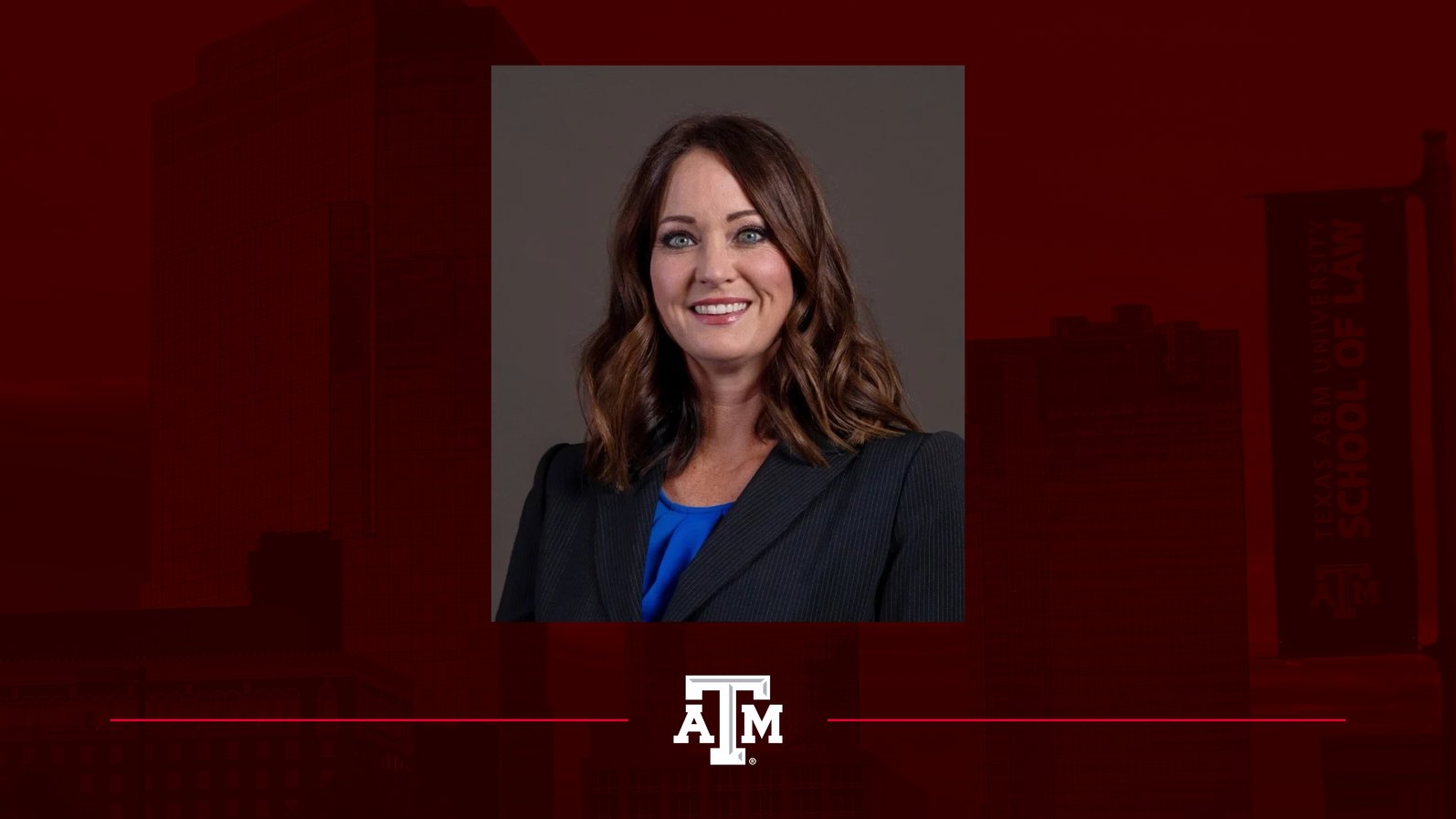Day Three – Water, Wisdom, and Wandering: Exploring the Shafdan Wastewater Treatment Plant, Givat Haviva, and Jaffa
By: Anna Eckhoff '25
This article is part of a series of reflections prepared by students enrolled in the Texas A&M School of Law 2023 Global Field Studies Program: Israel. Click here to visit the entire series.
Today, our second day in Israel, we visited one of the world's leading wastewater treatment plants, the Shafdan Wastewater Treatment Plant—owned and operated by Mekerot (Israel's national water company). Israel has long faced significant water scarcity challenges due to its geographical location and climate. However, instead of wilting under these adversities, the country has emerged as a global frontrunner in water reuse technologies, leading the world in water reuse at 87%. (The U.S. reuses about 10% of our water.) Shafdan is a shining example of this innovative approach to water management.
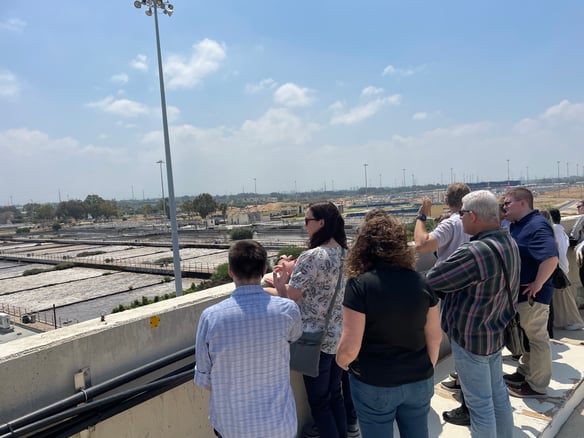
From the top of one of the anaerobic digestors, we were able to view how wastewater is moved through the treatment process at Shafdan. We got a bird's eye view of the bioreactor pools where bacteria progressively break down organic material as the water flows through each of the pools.
Our tour of the plant was led by Mario Kummel, a Water and Wastewater Process Engineer within the water quality division at Mekerot. He explained each stage of the innovative wastewater treatment process. The facility processes wastewater from the Greater Tel Aviv Metropolitan area, filters and disposes of nonbiodegradable waste like wet wipes, and then treats it through a multi-step process that enables the treated water to be used for agriculture in the arid Negev desert region. Guides on our tour highlighted that Shafdan currently carries 140 million cubic meters of recycled water a year from Israel’s central metropolitan area to advanced agricultural management in the southern Negev desert.
The Shafdan plant uses a highly sophisticated system involving physical, biological, and chemical stages to treat wastewater. The final effluent is of high enough quality to be used for irrigation without any additional treatment. It's awe-inspiring to think about how this process transforms wastewater into a resource that's helping sustain agriculture in one of the driest parts of the world.
The treatment plant is designed to maximize the sustainable use of water resources while minimizing environmental impact. Wastewater sludge is digested anaerobically to generate biogas (primarily methane), which is then utilized as a source of renewable energy. Not only does this offset part of the plant’s energy needs, but it also reduces the overall carbon footprint.
Additionally, we had the opportunity to meet with David Weinberg, National Planning & Treated Effluent Reuse Manager from the Environmental Health Dept, Israeli Ministry of Health. He introduced us to Israel’s Water Law of 1959, which creates a framework for the control and protection of Israel's water resources. Notably, all water sources in Israel are public property and owned by the state, which differs from the U.S., where water rights are a form of private property typically conferred to landowners. The articles within the Water Law grant the Israeli Water Authority the power to set standards for and regulate water quality. Standards vary based on different end uses such as drinking, bathing, irrigating tree crops, and irrigating other crops. We learned about several of the innovative solutions related to desalination and wastewater treatment Israel has employed to overcome the unique water issues the country has faced due to its geography.
As law students, we were especially interested in learning more about government challenges and any efforts to provide decentralized, off-grid water and wastewater solutions to citizens in remote villages who are not currently connected to the national, centralized systems. Additionally, we were very curious about how Shafdan’s operations and regulations are closely aligned with Israel's unique water laws, which prioritize water reuse to promote sustainability. The country's legal framework concerning water reuse is not only robust but also forward-thinking, considering the environmental and societal impacts of water scarcity. It’s a practical example of how policy can empower technological advancement and societal resilience in the face of environmental challenges. Our visit at Shafdan left us grappling with how innovators might work collaboratively and strategically with government partners to leverage these policies in ways that can similarly empower marginalized and unrecognized communities that don't currently have equitable access to these systems.
Overall, our visit offered an invaluable look at how technology, law, and policy can come together to address critical issues such as water scarcity. The Shafdan Wastewater Treatment Plant is a testament to Israel's innovative spirit and commitment to sustainable water management. As the global challenge of water scarcity becomes more pressing, it is clear that innovative solutions like the ones at Shafdan are essential to address the immediate issues, but also lay a sustainable foundation for the future.
Pieces of Peace in Givat Haviva
After visiting Shafdan, we toured Givat Haviva, a center dedicated to promoting a more cohesive, shared society within Israel through research, municipal and regional partnerships, education programs, and public engagement. Our introduction to Givat Haviva involved an enlightening discussion with Mohammad Darawshe, Givat Haviva's Director of Planning, Equality, and Shared Society. In addition to serving on the council of his village, Iksal, where 28 generations of his family have resided for over 800 years, he previously served on the Strategic Planning Team Authority for Economic Development of Arab Sector at the PM’s Office.
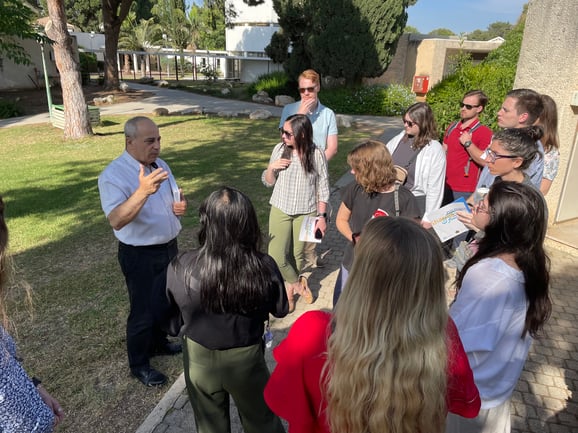
An expert in Jewish-Arab relations, Mohammad introduced us to the intricate social and historical landscape of Israel. In his discussion, “From Coexistence to Shared Society: An Introduction to Arab Society in Israel,” Mohammad highlighted the deep-seated complexities of Jewish-Arab relations, taking us back to the foundational, contrasting narratives between the Muslim and Jewish faiths on whether Abraham chose to sacrifice Isaac or Ishmael. Throughout his overview of the region’s complex historical background, Mohammad underscored the necessity of acknowledging and understanding divergent narratives, which, in many ways, mirrors the very core of effective dispute resolution in law. He advised our group of future lawyers that the most important attribute of a third-party mediator or bridge-builder is trustworthiness. Similarly, another tour guide on our trip poignantly noted that the scarcest resource in Israel is trust.
Mohammad also highlighted another education project he helped to launch called the Hand in Hand Schools. Aimed at mitigating social divisions between Jewish and Arab citizens of Israel, this initiative fosters mutual understanding from an early age by exchanging teachers between Jewish and Arab schools. The project illustrates how education can serve as a proactive form of dispute prevention, instilling principles of respect and empathy early on—an approach that has significant parallels with the preventative side of dispute resolution in law.
Additionally, Mohammad shared his experience building Sharikat Haya, an empowering project designed to integrate Arab women into the Israeli job market. By providing training, job placement, and ongoing support, this project aims to address economic disparities and societal perceptions, effectively serving as an intervention model to address potential areas of conflict and contention. When exploring the reasons why Arab women were underrepresented in the workforce, Mohammad pointed out that the common assumption was that patriarchal ideology was the greatest barrier. However, through the project, Mohammad and a team of other experts discovered that lack of equitable education, transportation, and childcare were among the most significant hurdles inhibiting employment among Arab women. In response, the project began investing in daycare and public transportation in Arab communities and has helped to empower tens of thousands of Arab women to join the Israeli workforce.
Beyond these inspiring initiatives, I was profoundly moved by our tour of Givat Haviva's art center. Within the Givat Haviva International School, student artists from diverse backgrounds collaborate through a shared, universal language in art, music, and dance. These personal expressions seem to cut through differences, connecting artists in transformative ways where words often fall short. It was an affirmation of art's potential to build bridges and foster empathy. These young artists have discovered a space where they can freely express their own personal narratives and also appreciate the narratives of others, offering a glimpse of the shared society that Givat Haviva envisions by building a diverse community of student leaders committed to cross-cultural cooperation and conflict resolution.

Givat Haviva represents a microcosm of dispute resolution within a societal context. The understanding and acknowledgment of multiple narratives, the fostering of mutual respect through education, and the efforts to address economic and cultural disparities all parallel important dispute resolution goals in the legal field.
As I continue my studies in law, the lessons underscored at Givat Haviva will undoubtedly shape my understanding and approach to dispute resolution. Recognizing and appreciating diverse narratives is not merely an exercise in open-mindedness; it is a fundamental cornerstone of effective dispute resolution and a critical tool for any lawyer seeking to navigate and resolve complex conflicts.
Ancient Echoes and Modern Whispers in Jaffa
Our day of learning about Israel's unique approach to wastewater treatment and intercultural empathy concluded with an evening free for exploration. Deciding to delve further into the local culture, a group of us chose to visit Jaffa, an ancient port city with a diverse heritage before merging into modern Tel Aviv - Jafo.
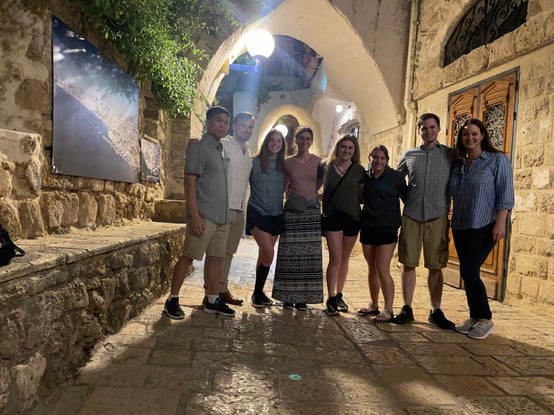 We had just enough time to view the sunset from the gorgeous beach in Tel Aviv before exploring the narrow and twisting, cobblestone alleyways of Jaffa, which provided an insightful contrast between natural landscapes and man-made architectural relics.
We had just enough time to view the sunset from the gorgeous beach in Tel Aviv before exploring the narrow and twisting, cobblestone alleyways of Jaffa, which provided an insightful contrast between natural landscapes and man-made architectural relics.

We happened upon several quirky and intriguing stops including a fully suspended orange tree by Israeli artist Ran Morin. Morin’s creation intended to reflect on society's relationship with nature, which was particularly interesting to our group given our interest in water and environmental law. Another unexpected find was the world’s largest steel spoon, certified by the Guinness Book of Records to be over 53 feet long.
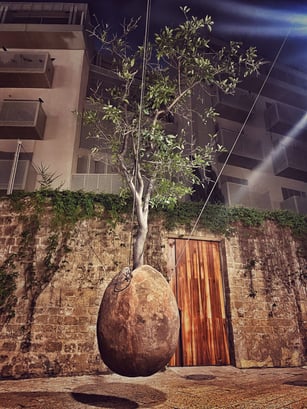
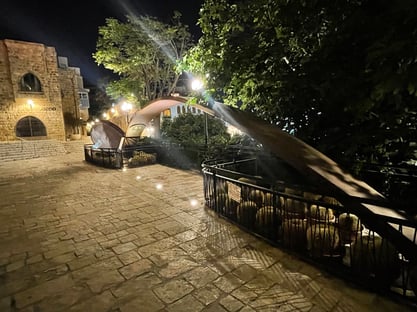
This ancient port city carries the echoes of myriad civilizations that have once laid claim to it—from Egyptians and Canaanites to Romans and Ottomans—each leaving their indelible mark and an unsettling reminder of the enduring human propensity for conflict. Yet, amidst these stones imbued with centuries of turmoil, we also felt a deep sense of unity—a shared human spirit that has persisted through the ages. It felt like a testament to the resilience and the universal values and aspirations that continue to inspire humanity toward innovative solutions to complex problems.
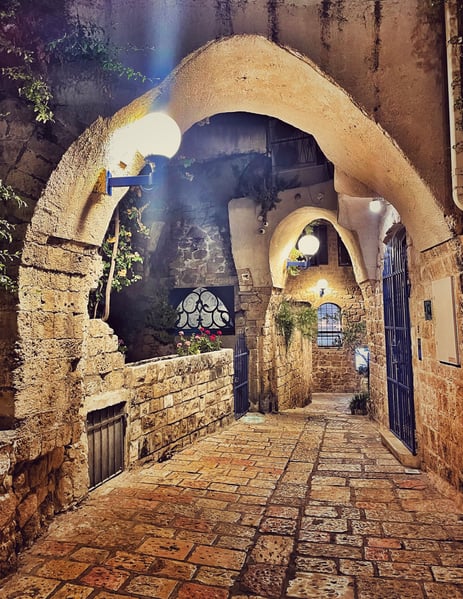
Learn more about Texas A&M University School of Law's Global Law and Policy Program, Aggie Dispute Resolution Program, and Energy, Environmental, and Natural Resource Systems Law Program
